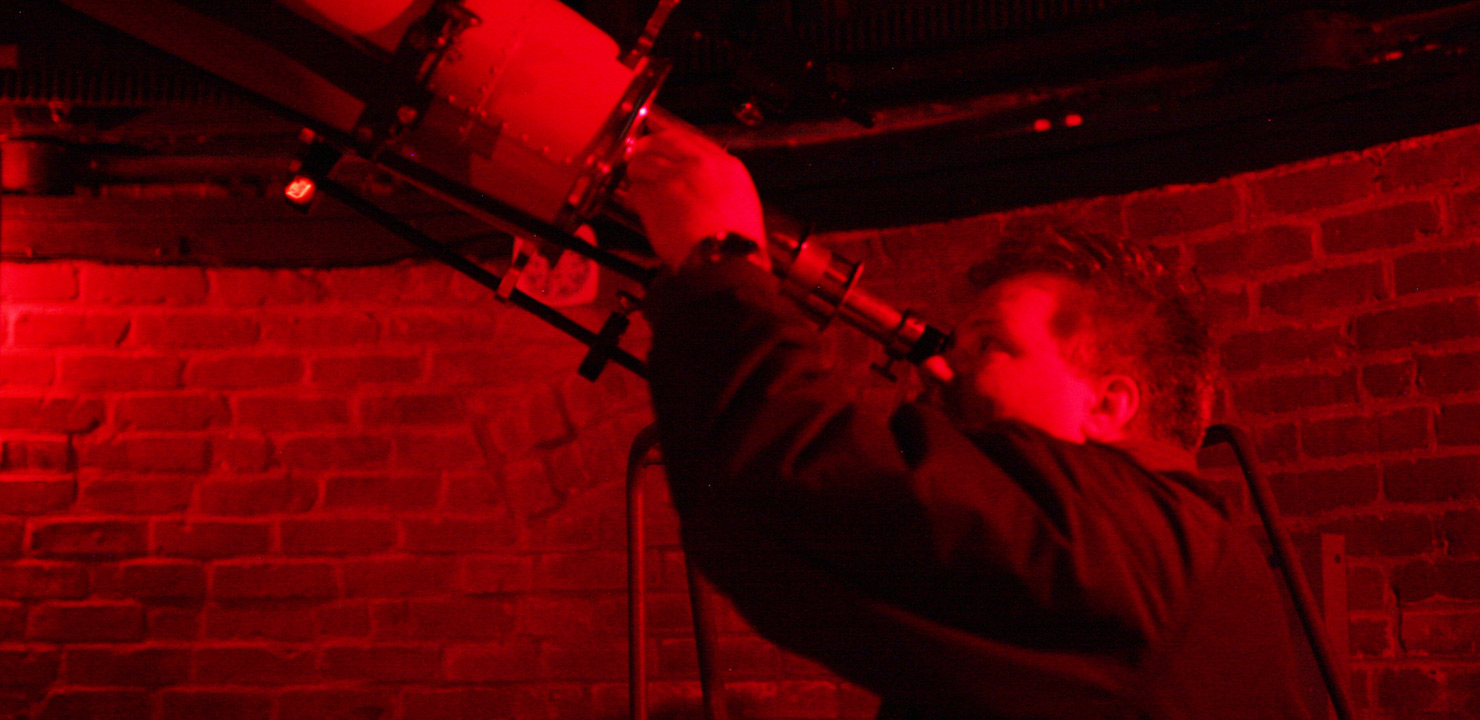
Full Circle: An Amateur Astronomer's Journey Home
June 2013 :
It was late March 2013 when I decided to visit the Seagrave Memorial Observatory, having already decided to apply for membership in the organization. I pulled into the parking lot around ten of eight and made my way to the main building, which I knew from my research on the web, housed the Society’s centerpiece instrument. I climbed the stairway and joined the group of people who had gathered to view the heavens that evening. It was there that I met Dave Huestis and his very capable assistant, a young man by the name of Alex Bergemann. As I got to know this young man, I soon realized I was looking in the mirror, a mirror that added a temporal distortion of about forty years.
December 24, 1968
It was Christmas Eve and I was sitting in my second grade classroom at St. Joseph School in Pascoag, Rhode Island. Every member of my class, along with the first and third graders, was glued to the television set. Three American astronauts, Frank Borman, Jim Lovell, and Bill Anders, were orbiting the moon in the Apollo 8 spacecraft. I remember thinking; we’ve actually put men in orbit around the moon. This wasn’t science fiction, it was real. That morning, I think every child in the classroom wanted to be an astronaut.
The Space Race was well underway and it looked as if the United States was finally taking the lead from the Soviet Union. The dream of stars seemed to fill our culture as many popular TV shows would indicate. Three years prior, in 1965, the introduction of Irwin Allen’s Lost in Space teased our imaginations, and a year later, Gene Roddenberry followed with Star Trek, one of the finest science fictions shows to grace the TV screen. In February of 1968, Stanley Kubrick released what was to be called the proverbial good science fiction movie; 2001: A Space Odyssey. But all of this utterly paled in comparison to the real life drama which was played out on the classroom television that morning.
The following summer, my family drove down to Wilmington, North Carolina to visit with relatives. Most of my mother’s family lived down there, as well as my father’s parents. (They moved back to Rhode Island the following year.) While we were visiting, I met my older cousin Keith, who was an avid amateur astronomer. One night, the sky was clear and Keith set his telescope up in the backyard. We spent the next few hours looking at the stars. I don’t remember seeing any planets, but this was over forty years ago. It did not matter, I was hooked. When we came in, I told Mon and Dad that I wanted a telescope for Christmas.
Unfortunately, it would be another couple of years before my parents could afford to grant my request. I didn’t know it at the time, but they were having trouble making ends meet. It didn’t help that Dad was still going to night school, at Bryant College, in an effort to finish his business degree.
 But, my interest in astronomy never wavered, in fact, my grandfather helped keep it alive when he presented me with the August 1970 National Geographic Magazine, Volume 138, Number 2. The magazine contained an article titled Voyage to the Planets written by Kenneth Weaver as well as a map titled, The Heavens. That map hung in my bedroom for the next several years. There was also an article about the March 7, 1970 solar eclipse contained within that issue. I wore the magazine out by reading it over and over again, dreaming of the planets, stars, galaxies, and the thought of exploring the cosmos.
But, my interest in astronomy never wavered, in fact, my grandfather helped keep it alive when he presented me with the August 1970 National Geographic Magazine, Volume 138, Number 2. The magazine contained an article titled Voyage to the Planets written by Kenneth Weaver as well as a map titled, The Heavens. That map hung in my bedroom for the next several years. There was also an article about the March 7, 1970 solar eclipse contained within that issue. I wore the magazine out by reading it over and over again, dreaming of the planets, stars, galaxies, and the thought of exploring the cosmos.
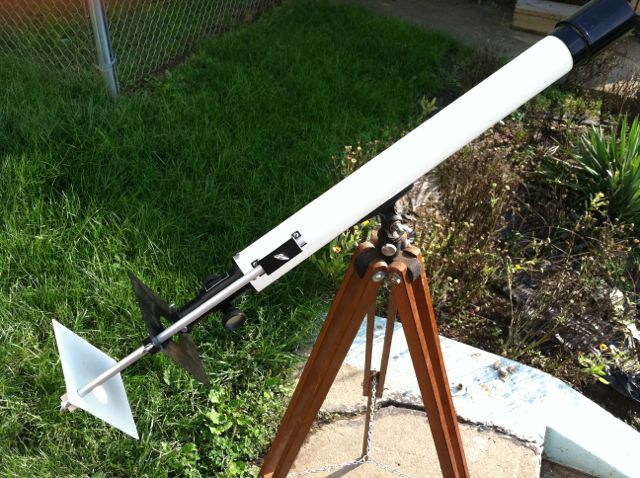
On Christmas Day, 1970, I received my first telescope, a Sears and Roebuck 100 power refractor with a sun projection screen and an erecting lens which increased the power to 150x. I was elated to say the least. A few nights later we had clear skies and I was able to take the scope out for first light. I vividly remember the night being bitterly cold but I knew Saturn was going to be up in the constellation of Taurus. Using my planisphere, I located the target constellation and started searching for the ringed planet. When I moved to the third object, I found my quarry! I had seen Saturn in magazines, including images from some of the world’s largest telescopes, but seeing the ringed wonder, with all its glory, with one’s own eyes was an experience I will never forget. I soon forgot about the cold and would have stayed there all night if it wasn’t for my mother worrying about me catching a cold.
I spent the next several nights outside; unencumbered by the temperature, in order to take in the magnificent beauty that is Saturn. I eventually turned to the stars, but, at the time, I considered them just boring points of light. (I would change my mind about that later.)
Looking at the moon was another favorite pastime as I could often observe from the comfort of my bedroom window. I soon learned that the best views were obtained with a crescent moon rather than when it was full.
Around late spring or early summer, I spotted what I thought was a bright star in the southern sky. I carted my scope onto the neighbor’s deck (with their permission of course) and trained the scope on the “star”. It turned out that this wasn’t a star at all; it was the King of the Planets, Jupiter. Even at 100x power, the four Galilean moons were plainly visible as well as the atmospheric bands. Also visible, much to my delight was the Great Red Spot, the hurricane which has raged for over four hundred years. I was just as excited, about Jupiter, as I was the first time I saw Saturn through the scope.
In addition to my observations, I continued to study everything, and anything I could get my hands, on that related to astronomy, planets, space, or space travel. I was reading, and much to my parents delight, understanding my father’s college science textbooks. I memorized the facts about the solar system, including distances from the sun, number of moons, relative sizes, and so on. My fourth grade science project was titled The Nine Planets and I won 1st place in my grade in the school science fair. Truth be told, I never expected to even show, much less come in first. I found out later that my knowledge of the material is what impressed the judges.
I spent quite a bit of time using my scope for solar observing. With the simple but effective solar projection setup, I was able to watch as sunspots traversed the solar surface. On July 10, 1972, a partial solar eclipse was to occur in the greater Rhode Island area. I set my scope up and watched as the moon, ever so slowly, covered the solar disk. Alas, the clouds rolled in ten minutes before the point of maximum coverage and rain began shortly thereafter. Ah, the trials of an amateur astronomer.
It was around this time that I became interested in a TV show (that would later reignite my waning interest in astronomy) called UFO. It was a somewhat obscure British offering, but, in my opinion one of the best speculative science fictions shows of the twentieth century.
Sometime in late 1972, I learned that my cousin Keith had been diagnosed with leukemia. The prognosis was not good and he would succumb to the disease before our next visit to North Carolina. It was the first time I had come face to face with my own mortality. (When you are a kid, you think that you will live forever.)
December 7, 1972 marked another milestone in the space race with the launch of Apollo 17, the last manned mission to the moon. My Uncle David, who worked for NASA, had told me the prior year that 17 would be the last lunar mission, but NASA had plans for a new space station called Skylab, and a re-useable spacecraft known as the STS (Shuttle Transportation System).
While astronomy still remained near the top of my list of interests, it gave ground to other pastimes as I progressed into junior high school. I didn’t know it at the time, as I still wanted to be a pilot, but my interest in electronics would someday evolve into my livelihood.
By the time I became a freshman in high school, I knew my dream of flying was destined to be only a dream, due to my eyesight. To keep my options open, I took college prep classes including accelerated sciences. In the advanced group, doing a science project was mandatory and I turned back to astronomy for my project. This would be my first exposure to the world of astrophotography. Remember, this is back in the day where digital cameras didn’t exist, and motorized RA drives were well beyond the budget of most middle class families. Still, I was able to get a few decent shots of Venus, Jupiter, and the moon. The project also gave me some experience with black and white developing and printing.
By the summer of 1976, I was unsure about what I wanted to do with my life, and I knew that I was running out of time to decide on a career path. I didn’t want to make the same mistake my father did, but as a sixteen year old kid, I wasn’t sure what to do about it. When I was unable to find a summer job, my parents sent me to the Project Horizons program at the William M. Davies Vocational Technical School in Lincoln Rhode Island. I had been to the program in the summer of 1974 and enjoyed exploring the different trades, taught by the school, so I agreed to go. It would prove to be a turning point in my life. I knew I had an aptitude for electricity/electronics, as well as the data processing program, so I needed to decide if any of these career paths were right for me. In the process, I discovered amateur radio, a pursuit which still competes with astronomy for my attention.
By the end of the eight week program, I knew what I was going to do. The one career path that encompassed all of my interests was the electronics field. In September of 1976, I transferred to Davies Voc-Tech and dove headlong into my studies. Contrary to popular belief, the academic program at the school sported a college prep program for those students in the technical fields, such as, electronics, drafting, data processing, and health occupations. I worked my tail off to maintain an “A” average and my telescope was relegated to the closet, only brought out on a rare occasion of a lunar eclipse or when Jupiter happened to be up.
When the Space Shuttle Columbia was first launched on April 12, 1981, my interest in the space program was revived for a time, but other concerns would soon occupy my thoughts and my passion for observing the night sky with my telescope was all but forgotten. I still tried to catch the shuttle launches and, as fate would have it, I was watching when seven Americans, in the words of Ronald Reagan, “slipped the surly bonds of Earth, and touched the face of God.” Like many Americans, the Challenger disaster was a kick in the gut for me.
As the next fifteen years passed I would sometimes find myself looking up at the stars with nothing but my own eyes. The siren song of the heavens provided some solace for a rather turbulent time in my life.
In 2002, I married the lady I had been dating since 1993. We closed on our first home a few days later. Susanne knew of my interest in the stars and bought me a new telescope for Christmas, that year. It was a Bushnell 6” reflector with a motorized equatorial mount. While the optics seemed to be okay, the mount was unstable, and having gone through the same frustration with my first scope, I didn’t want her to waste good money on something that would end up collecting dust. When I told her how much we would have to spend to do what I wanted to, we both decided to wait until we were a bit more financially secure before we would make that kind of investment.
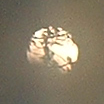 On May 15, 2003, a partial lunar eclipse occurred while I was at work. Not wanting me to miss it, my wife tried her hand at astrophotography. Using our little 2 megapixel point and shoot, she clicked off about twenty shots of the moon in various phases of eclipse.
On May 15, 2003, a partial lunar eclipse occurred while I was at work. Not wanting me to miss it, my wife tried her hand at astrophotography. Using our little 2 megapixel point and shoot, she clicked off about twenty shots of the moon in various phases of eclipse.
Well, she got an “A” for effort. After all, it’s the thought that counts.
In late 2005, my employer was laying people off, and I suddenly found myself beating the pavement looking for a new job. The sudden loss of income resulted in us having to drain our savings account (including my telescope fund) to keep the mortgage and bills paid. I was out of work for almost six months. I expanded my job search into central Connecticut and found a two-way radio company looking for an experienced and licensed technician. I started with WPCS on May 6, 2006. It took me a couple of years, pulling down overtime, and negotiating pay raises to re-establish some financial security. I did manage to procure a decent pair of Nikon 10x50 binoculars. I use them to check the antenna feed lines on radio towers, but they also can be used for star gazing. It was a win-win. Using my binoculars, I often would gaze up at the night sky not looking for anything particular. I stumbled on a few star clusters by accident. The passion for astronomy was re-awakening.
It was in late 2009, when I discovered Fan-Fiction.net, a repository of stories written by the fans of both past and current TV shows. Remember that British TV show I mentioned earlier? One of the first sections a stumbled on was a collection of stories which had been written for that show.
Science fiction has always been one of my favorite reading genres so I decided that I would try my hand at writing a UFO story of my own. My first story was long, over eighty thousand words and I spent four months writing it. When I finished the first story, I added companion short stories to supplement the saga and some of my work mentioned astronomy. Suddenly, I found myself longing to delve back into my boyhood hobby.
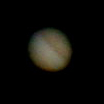 After doing some research, I ordered the Meade LS-6 in November of 2010. The scope arrived a few days before Christmas and saw first light on December 24. In addition to the telescope, I had ordered a T-ring and T-mount for my 35mm Digital Rebel. I took my first images of Jupiter and the Great Orion Nebula on January 3, 2013.
After doing some research, I ordered the Meade LS-6 in November of 2010. The scope arrived a few days before Christmas and saw first light on December 24. In addition to the telescope, I had ordered a T-ring and T-mount for my 35mm Digital Rebel. I took my first images of Jupiter and the Great Orion Nebula on January 3, 2013.
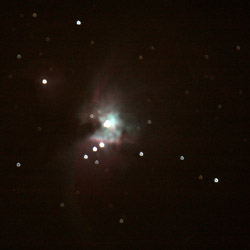
As one can see, I still have a ways to go on the astrophotography learning curve. I soon realized that I hadn’t purchased a suitable platform for serious astrophotography work. Fortunately one of my co-workers was in the market for a portable scope and the LS-6 fit his needs perfectly. I parted with the LS-6 and ordered the 8” LX-200.
The new scope arrived a couple weeks later. Compared to what I was used to, this telescope was a monster. I’m sure glad I didn’t order the 10” model. I spent several sessions just getting used to the scope before I tried it out with the camera. On March 19, 2012, the moon was due to make a close approach during its full phase. The weather looked as if it was going to cooperate so I set up to take some astrophotos. I had just received a 6.3 focal reducer and the moon would be a good target to try it out. I also wanted to take another crack at M42.

I have to admit, I was very pleased with the way this one came out. I took several photos that night, most of them of the moon, but I also managed to capture the Pleiades, the Double Cluster (Caldwell 14), Sirius, and Betelgeuse.
Of course the moon was the star of the show that evening. I started at 1/125 of a second exposure and continued to lower the value until I was at 1/4000 of a second. I suppose I could have dropped the ISO setting down but 1/4000 seemed to be just right.
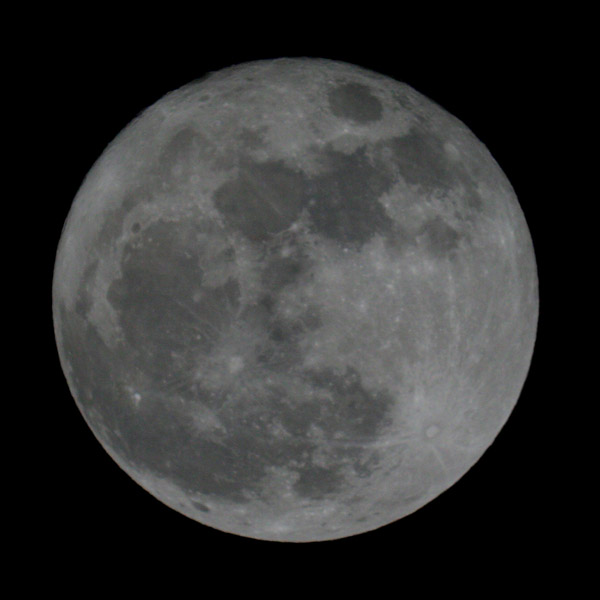
My interest now revived, I started looking on the internet for star parties and dark skies. It was then that I came across the Skyscraper website. Having learned the hard way to look before you leap, I spent a great deal of time on the website to ascertain what the organization was all about. I decided to submit my application for membership at the April, 2013 meeting.
Present Day
As I gazed at the rings of Saturn, through the Alvan Clark refractor, I felt as if I had finally come home. And while it is true that astronomy shares the top spot with my radio interest, the two are uniquely compatible. I’m working on a way to display the voice of Jupiter on the computer using a program I use for precise frequency measurement. If things work out the way I hope, I may be able to give a radio astronomy presentation to the group.
As I listened to the oohs and aahs from the people gathered in the dome I fondly remember my own reaction four decades ago. I still hear the siren sound of the stars.



